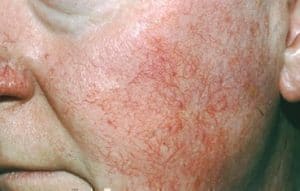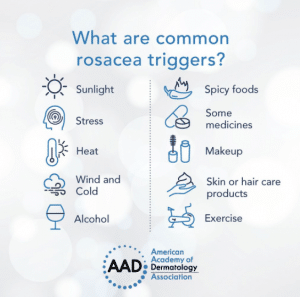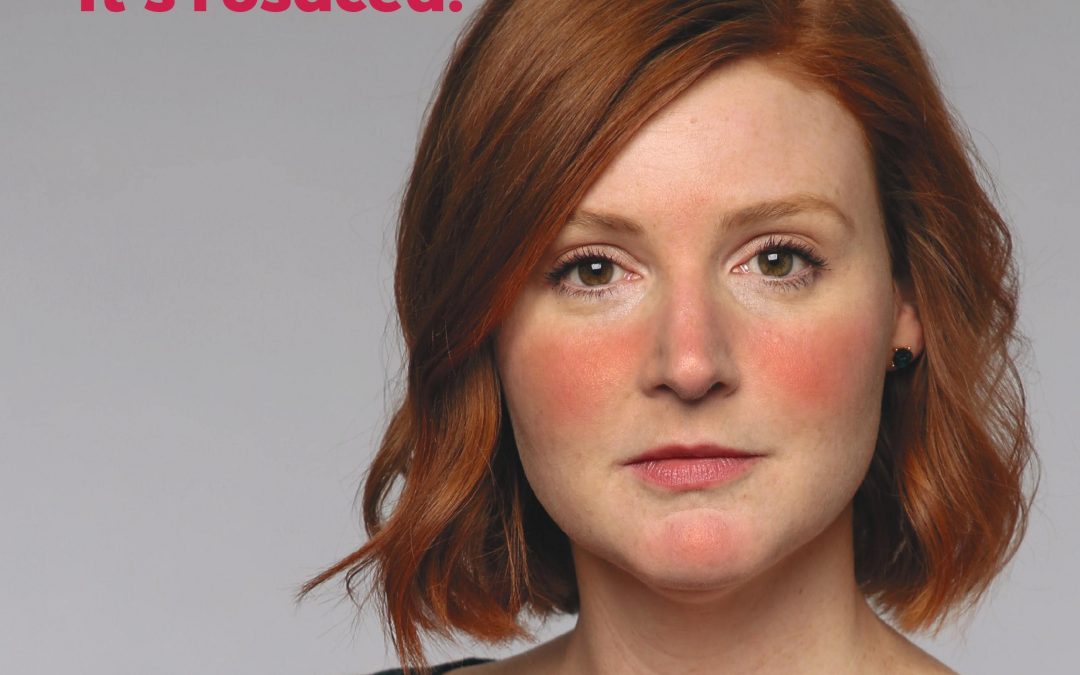Did you know that over 3 million Canadians have rosacea? Rosacea is a common, chronic skin problem that I regularly diagnose and treat. It usually starts with facial redness and easy blushing. Many patients are not aware they have rosacea, nor that treatment is available. The signs of rosacea may cause embarrassment, social anxiety and low self esteem.
What is Rosacea?
Rosacea is a skin condition that begins with easy blushing and flushing. Over time, areas of persistent redness appear on the nose and cheeks. The chin, forehead and neck may also be affected. The skin may feel rough or dry, and feel stinging or burning. Tiny red blood vessels may develop on the nose and cheeks.
Types of Rosacea
Rosacea can cause more than redness. There are four subtypes of rosacea:
- Vascular Rosacea: redness, flushing, visible blood vessels

- Inflammatory Rosacea: redness, acne-like blemishes, and swelling

- Phymatous Rosacea: nasal skin thickens and has a bumpy appearance

- Ocular Rosacea: red, irritated, swollen eyelids and styes

Former President Bill Clinton and Diana Princess of Wales struggled with rosacea.
What can Trigger a Rosacea Flare?
Anything that causes rosacea to flare is called a trigger. Classic triggers include:
- Sunlight
- Heat
- Alcoholic beverages, especially red wine
- Spicy foods
- Hot beverages
- Temperature change (wind, cold, exercise)
- Some skin and hair products, and some makeup products
- Some medications
What causes Rosacea?
The truth is scientists are still investigating the cause of rosacea. Possible clues include:
- Genetics (as there is often a family history of rosacea)
- Demodex mite (often found in large numbers on the skin of rosacea patients)
- Immune system (Over reaction to bacterium? Abnormal processing of the protein cathelicidin? H. pylori infection?)
What are the Signs and Symptoms of Rosacea?
There are many signs and symptoms of this common, chronic skin condition. Let’s look at the four subtypes of rosacea:
1. Vascular Rosacea: Facial redness, blushing, and visible blood vessels
- Central face redness and flushing
- Telangiectasia (= visible facial broken blood vessels)
- Sensitive skin which may burn and sting
- Dry skin which may feel rough or scaling
- Blush more easily than others
- Swelling of the involved areas of the face
2. Inflammatory Rosacea: Acne-like lesions
- Red bumps and pustules on the central face
- Pimples tend to wax and wane
- Sensitive skiing which may burn and sting
- Telangiectasia (= visible facial broken blood vessels)
- Skin may be oily
3. Rhinophyma: Thickening of the skin
- A rare subtype, more common in men
- Thickened skin, with a bumpy texture, most common on the nose
- Associated with visible broken blood vessels, large pores and oily skin
- May also affect the cheeks, chin, and forehead
4. Ocular Rosacea: In the eyes
- Eyes are watery or appear bloodshot
- Eyes feel gritty (like there is sand in the eyes)
- Eyes sting, burn, or itch
- Eyes are very dry
- Eyes may be light sensitive
- May develop cyst on the eyelid (like a stye)
How to Treat Rosacea
Unfortunately, rosacea can not be cured. My goal in planning a treatment program is to reduce signs of rosacea, ease discomfort, and prevent rosacea from worsening.
How I treat rosacea starts with education.
✤ Identify and avoid rosacea triggers. This is an important step. By knowing what triggers your flare-ups you can:
- Reduce flares of rosacea
- Achieve better results from your treatment
- Prevent progression of rosacea

To find your rosacea triggers, you need to be a detective. I often recommend keeping a rosacea diary for a week or two. Jot down what you eat and drink, your skin and hair care products used, and environmental exposure (heat, cold, wind, sun) that could cause a rosacea flare.
✤ Sun Protection 24/7. In addition to sunscreen, seek shade, wear a hat and sunglasses. I recommend sunscreens which are:
- Broad spectrum with an SPF of 30 or greater
- Fragrance and dye free
- Mineral based sunscreen containing zinc oxide +/- titanium dioxide are least likely to irritate sensitive skin
- Avoid products containing alcohol (spray or gels)
✤ Gentle skin care. Patients with rosacea struggle to find cosmetics and skin care products they tolerate. Avoid the following ingredients:
- Alcohol
- Fragrance
- Menthol and camphor
- Glycolic acid
- Lactic acid
- Sodium lauryl sulfate (often found in shampoo and toothpaste)
- Urea
To minimize irritation, choose a cream rather than a gel or lotion. Do not use toner or astringent.
For the redness of rosacea, I recommend:
- Camouflage. Foundation, concealer, or green tinted moisturizer/primer will heal to conceal your redness.
- Antioxidants. Improve the effectiveness of your sunscreen, reduce oxidative stress from the environment, and stabilize blood vessels.
- IPL (Intense Pulsed Light) and Laser Treatment. For people with persistent redness or visible blood vessels this is a game changer! Many patients will see complete clearing of their redness. This clearing can last for years. A series of treatments is usually required to see results.

For the acne-like lesions of rosacea, a prescription topical or oral medication may be required.
Rosacea Treatment
Topical:
- Ivermectin (In Canada sold as Rosiver Cream). This is my go to for mild to moderate inflammatory rosacea. It is well tolerated, as it is a cream formulation. It has an anti-inflammatory action. Ivermectin cream is applied at bedtime.
- Metronidazole (In Canada sold as Metrogel and Noritate cream). It has antimicrobial and anti-inflammatory effects, and is considered the gold-standard therapy for rosacea. I find the gel formula can be irritating to some rosacea patients. We currently do not have a lotion form available in Canada. Metronidazole topically can be used once or twice a day.
- Azelaic acid (In Canada sold as Finacea). This has an antibacterial action. I find it not as well tolerated as ivermectin and metronidazole. Can be helpful for post-inflammatory hyperpigmentation.
Oral:
- Antibiotics. Used for their anti-inflammatory action. Oral antibiotics used most often for rosacea include tetracycline, doxycycline, and minocycline. I use as first line therapy for severe rosacea, and as second line therapy for moderate rosacea not responding to topical therapy.
- Isotretinoin. (Accutane, Epiuris) Although prescribed chiefly for severe cystic scarring acne, may be considered for severe rosacea not improving with oral antibiotics.
Rosacea does not resolve on its own, and if untreated may worsen with time. If you or someone you know has rosacea we can help. A referral from the primary care provider is required to book an (OHIP covered) rosacea consultation with Dr. O’Neill.
WE KNOW SKIN!
We can help provide solutions for rosacea, and all your skin care needs.

